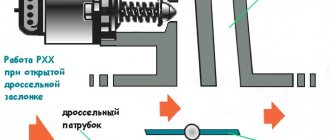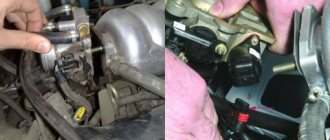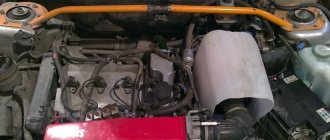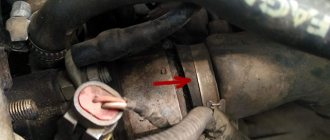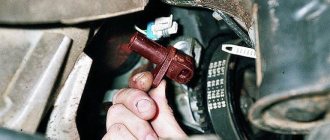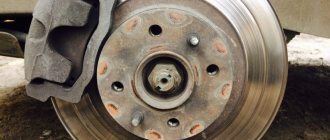Replacing the idle speed control on a VAZ 2109 with your own hands
The idle speed controller (IAC) is responsible for the engine idle speed; with its help, the engine is able to maintain the optimal speed required during operation without load to save fuel and increase the service life of the engine's operating mechanisms.
In addition, idling allows the engine to warm up before starting to drive. The idle air control is located on the left side of the throttle assembly and consists of three main components:
A rod with a conical needle at the end.
Features of the sensor device, its operating procedure
In addition to adjusting the air supplied to the engine when the throttle is closed, the sensor is used when warming up the internal combustion engine to the required operating temperature in the winter season. When the ignition is turned on in the car, the rod of the idle speed sensor element extends completely and rests against the calibration hole provided for this purpose. The sensor device “removes” the steps and returns the valve to its original position. When the engine is running, at the moment the steps increase or decrease, the amount of air flow penetrating through the hole simultaneously changes. It turns out that the right amount of air mass enters the engine to ensure stability at idle speed. The dimensions of the regulatory device are small; it can easily fit in the palm of a person. Structurally, the sensor consists of three elements:
- stepper electric motor;
- springs;
- rod with a conical needle at the end.
The device is firmly fixed with a pair of threaded screws on the body of the throttle.
Principle of operation
The operating principle of a pilot (indirect) solenoid valve for water can be understood from the attached diagrams of the device. Regardless of the type of electric valve used (normally closed, normally open or bistable), the operation of an electrically controlled valve will look something like this:
- The solenoid valve is initially closed and no electrical signal has yet been sent to the coil. Water is locked in the inlet part of the valve by a stem with a gasket;
- When an electrical signal enters the coil, an electromagnetic force arises in the solenoid, which draws the rod (plunger) into the inside of the coil, thereby creating space between the rod and the space above the membrane. The pressure under the membrane overcomes the pressure above and a passage opens for fluid to flow through the valve body.
When the tap is open, the same process occurs in the reverse order - the plunger is pushed out of the solenoid body and opens the water pressure above the membrane and, together with the force of the spring, closes the passage of water through the valve body.
The simplest operating diagram of a direct-acting solenoid valve:
- When a signal is applied (the electrical circuit is closed) to the solenoid, the rod is pulled into the inside of the coil and opens the passage of liquid due to the difference in pressure from the inlet to the outlet of the valve;
- when the signal to the solenoid coil stops (the electrical circuit is open), the spring returns the rod to its place and the valve seat blocks the flow of fluid through the valve body.
The solenoid valve can be made in different types of designs:
- saddle type solenoid valve;
- valve using a membrane floating amplifier;
- valve using a diaphragm amplifier with forced lift;
- piston type solenoid valve;
- gate type valve;a
- hinged valves;
- lever valves;
- poppet type solenoid valves;
- spool valves.
Based on the type of current supplied to the induction coils, solenoid valves can be divided into:
- installations with direct current in the network, which is typical for products where there is no high pressure and there is no need to create a large force of electromagnetic radiation;
- Products for networks with high pressures use alternating mains current to create an electromagnetic field of large magnitude on the rod or membrane in order to overcome large resistance loads in the water or gas environment.
Also, electromagnetic valves are divided according to the operating position of the rod into:
- Normally closed;
- Normally open;
- Bistable - with switching the position of the rod depending on the incoming electrical pulse signal.
Normally closed
An electromagnetic normally closed valve for water has a valve closed by a rod when the coil is de-energized, blocking the flow of liquid. When an electrical signal is applied to the solenoid coil, the rod and valve open this passage.
Normally open
Solenoid valves for water are normally open, such as, for example, UNIPUMP BOX series, when the selenoid coil is de-energized, they are in the open position and the liquid has a free flow through the valve body. When an electrical signal is applied, the valve and rod close this passage and the fluid flow stops.
Idle speed sensor VAZ 2109 (carburetor)
Its malfunctions can lead to the VAZ 2109 (carburetor) stalling at idle. The idle speed sensor and the solenoid valve of the VAZ 2109 carburetor are one and the same, here is a photo to confirm:
And this is a very unpleasant situation. This can happen far from the city, or right at an intersection, while stopping at a traffic light. It can be caused by overheating, hypothermia, or clogging.
Symptoms of a problem
This element is responsible for the operation of the engine at idle, which means that any malfunction will affect the stability of the idle speed. Among the main symptoms of HPP failure are:
- unstable idle;
- drop in crankshaft speed when additional electrical consumers are turned on;
- absence of increased warm-up speeds during cold starts of the power unit;
- stopping the internal combustion engine when turning off or changing gear.
These symptoms will not always be the cause of a malfunction of the VAZ-2109 idle speed sensor (injector), since the same symptoms will occur if the TPS fails. But if there is a problem with the throttle position sensor, the check engine light will come on. Since the IAC, or idle speed sensor, does not have its own diagnostic system, the lamp will not light up with the same symptoms.
Characteristics of the 3X sensor
If problems occur with the sensor, you need to immediately pay attention to the light bulbs and the sensor itself.
Purpose and principle of operation
The main task of this device is to turn on the warning lights, notifying people that the car is moving in reverse. It is clear that if the device is unusable, accidents may occur.
The VAZ 2109 reverse sensor works in this way: when changing gears, the shift fork is pressed against the device. This creates a short circuit in the wire and turns on the light, which informs about the movement of the vehicle in reverse.
Typical faults
The most popular problems are:
- The light bulbs burned out. If this happens, you need to remove it and check it with a multimeter.
- Broken contacts.
- The device will not work if the regulator contact is poor, as well as if the contact insulation is poor. Violation of insulation threatens to cause a short circuit.
- In the event of a breakdown, you need to make sure that the fuse in the mounting block is in good condition. If it is damaged or melted, it is worth replacing immediately.
- If the device itself fails, and the symptoms of the malfunction are such that all the lights will not work or, conversely, will work continuously, you need to replace it with a new one.
Symptoms of a problem
Under no circumstances should you ignore signs of failure of the idle speed sensor on your injection or carburetor VAZ 2109. This will make driving uncomfortable at first, but can soon cause a serious accident.
There are several main symptoms that may indicate problems with ICC:
- The revolutions spontaneously begin to increase and decrease;
- When turning on a cold power unit, the speed does not increase;
- When using additional electrically dependent devices, such as headlights or a heater, the speed immediately begins to drop at idle;
- When shifting gears or idling, the engine may stall.
This is not a complete list of possible symptoms, but they are all indirect. Therefore, to make sure that the problem lies precisely in the IAC, and not in other engine components, it is necessary to check the current state of the sensor.
Checking status
To check the current state of your IAC on a VAZ 2109 car, follow several sequential steps.
Verification step
Your actions
Apply the handbrake on the car and install chocks under the wheels. Safety should always come first when doing DIY car repairs.
You need to get to the sensor you are looking for, disconnect it from the power supply with wires, and then use a voltmeter to check for voltage. The minus is placed on the engine, and the plus is installed on the terminals of the wire block A and D
Turn on the ignition, check the voltage readings. Normally they are about 12 Volts. If the voltmeter shows lower values, there may be a problem with the battery charge level. If there is no voltage at all, you will have to check the entire computer and electrical circuit. Breaks are possible.
Carry out another test with the ignition on. Check terminals AB and CD one by one. In normal condition, the resistance across them should be approximately 53 ohms. If the IAC is working normally, the meter will show infinite resistance
With the idle speed control removed and the ignition on, connect the power supply to it. If at the same time the conical needle moves out, everything is fine with the device. If the cone-shaped needle does not extend, then the IAC is out of order and requires replacement
Having determined that the old idle speed sensor has already served its purpose on the VAZ 2109, it needs to be replaced. The procedure is completely doable without outside help.
Operation and repair
The VAZ 2109 carburetor, like all other parts, tends to break. Typically, a breakdown involves the failure of any spare part. In such cases, repair usually helps.
The first thing that can break is the accelerator pump. Its purpose is to enrich the fuel mixture, regardless of the air supply, when the throttle valves are opened. If, when you sharply press the gas pedal, the car jerks, it means that there is either not enough fuel, and significant gaps occur in the supply, or, on the contrary, there is too much of it, and it overflows the spark plugs. So, to avoid this problem, an accelerator pump is used. It regulates the exact amount of fuel required for normal engine operation, even when the gas is pressed hard.
The accelerator pump more often becomes clogged with sediment than breaks down, and then repairs are not needed, but simply cleaning is enough. But, if this is not the case, but there is still a breakdown, then the pump needs to be repaired urgently, otherwise operation of the engine of the VAZ 2109 car will be impossible, and you are guaranteed to have pedal failures.
The first symptoms that the pump is faulty is that when you press the pedal, the speed does not increase steadily, but floats. This is due to a shortage, or vice versa, an excess of fuel. The spark plugs do not have time to burn out all the gasoline, and they are simply flooded, so the car jerks while driving. Also, the pedal may fail when pressed.
Repair for such a breakdown is as follows:
We take out the sprayer; Shake it. If there is a characteristic knocking sound of the ball inside, then the sprayer is working, if not, then this will be the reason why the pedal failed; The pump has a rather heavy structure with parts. A large number of holes and channels increases the chance that the pump will clog, and pedal failure will be inevitable. If the holes are clogged, then repairs are not needed. You just need to buy carburetor cleaning fluid and use it to blow out the channels.
If the VAZ 2109 jerks when idling, and there are dips when you sharply press the gas pedal, then the EPHH control unit has a malfunction. Its repair primarily depends on which control unit is installed. They can be 4 or 6 pin. Repair of EPHH must be carried out by a specialist. If you do not have the appropriate knowledge, simply replace the part with a new one.
Purpose and application of solenoid valves
The solenoid valve is designed to control the flow of liquid and gaseous products at a distance. It can be shut-off or regulating. Control can be carried out either manually or using automation systems. In its design and purpose, an electromagnetic shutter is very similar to a regular one, with the difference that the locking element is driven not by muscular force, but by a solenoid, an electromagnet with a movable core.
Such shut-off and control devices are used both in complex industrial installations and in home heating and water supply systems, and in household appliances. They are also used in vehicles running on liquid fuel.
Functions
The IAC regulates the amount of air entering the engine when the throttle valve is closed. This suggests that the IAC performs the functions of automatically adjusting the specified engine speed when idling.
The regulator also takes part in the process of warming up the engine to optimal operating temperatures in winter. The operating temperature range of the IAC is quite wide - from -40 to +130 degrees Celsius.
The IAC, despite such important functions, is small in size and consists of three main elements:
- Stepper electric motor;
- Spring;
- A rod with a cone-shaped needle at the end.
The idle speed control is mounted on the throttle body with a pair of screws.
IAC location
Carburetor
Why is there a loss of speed at idle? This often occurs after washing the carburetor. To verify that there is a problem, you must:
- park the car on the site;
- turn the engine to idle speed.
Instability of indicators when the engine is on and incorrect operation of other electrical appliances indicates a short circuit that has occurred in the on-board network. The breakdown can be eliminated by testing the wiring and checking the reliability of the terminal connections.
Moreover, the cables of old cars are often locked even after washing. The whole point is that water penetrates under the body and floods the wires. Here, first of all, you need to check the harness leading to the fuse box - it is located very close to the windshield drain and often suffers from moisture. The problem is eliminated by sealing.
In addition, a drop in speed both cold and hot often indicates that:
- the carburetor is simply not adjusted properly;
- the plug has become unusable;
- there were problems with the vacuum brake booster;
- The spark plugs are not working properly.
Correct installation of the EM valve
It would seem, well, what’s so difficult, I screwed the valve into the carburetor and that’s it, but there are some nuances unknown to many, so if you do the installation yourself, without following them, you get new problems. So:
It is extremely important to correctly screw the EMC onto the carburetor. The most popular misconception is that it can only be screwed on by hand. Moreover, this can be heard not only from a beginner, but also from middle-aged and very experienced specialists in reputable car service centers. After such a recommendation, you and other drivers are in the deepest misconception. The point here is The problem is that a valve that is loosely tightened (by hand) begins to dangle in the thread, and a poorly squeezed rubber band adds additional air leaks, which leads to a lean mixture - just one of the common reasons for unstable speed. Also an erroneous technique, proposed in the article with the title “Capricious valve” in a magazine called “Behind the Wheel”: Let the engine idle, while turning off the power supply to the valve. Tighten it little by little until the combustible mixture normalizes and the speed increases; if the engine stalls, this means that the valve is tightened. Then start the engine and check the operation of the valve by disconnecting and connecting the power wiring. The whole point here is that the engine will stall as soon as the end of the nozzle has barely begun to enter its seat, but it has not yet reached the end. This “wisest” recommendation is also supplemented by: “If necessary, you can tighten the EMC about one more turn.” Doing this is just dangerous - if the EMC is pinched, you can ruin the XX jet, or ruin the seat for the jet, which is even worse, and if you break the thread located in the carburetor cover , then the price of repairs will skyrocket
The results obtained in this way:
- The first case - just change the jet
- The second case is replacing the carburetor cap
- The third case is to replace or repair the cover (drill out and insert a threaded bushing)
- For your information, the Repair and Maintenance Manual tells us a tightening torque of 0.4 kilograms per meter (corresponding to 3.68 Newtons per meter)
- For a valve with a body diameter of 20 millimeters, the force required is 40 kilograms, and for a 13 millimeter valve - 61.5 kilograms
- You are unlikely to be able to create such a force with your fingers, but with a key about 15 centimeters long - 2.5 kilograms is normal
- In the book by the author Tyufyakov it is written like this: “The valve must be tightly wrapped in the lid, until the rubber sealing ring is completely pressed into the spacer tube.”
The most sensible recommendation on how to install an idle speed solenoid valve on a VAZ 2109 is as follows:
- It is necessary to remove its rubber seal from the EMC, then screw it in by hand until it stops, while counting the revolutions and also remember in which location you have the contact
- Then we put on the elastic band, and screw it first by hand, and then with the “13” key to its previous position (which we remembered), but no further
- I’ll add on my own that with the VAZ 2109 engine running, the idle speed solenoid valve can be slightly unscrewed (no more than 120 degrees) to achieve maximum speed
Functionality check
Simple instructions will help you check the functionality:
- The functionality of the EMC is first checked with the engine stopped, turn on the ignition, removing and then putting on the wire going to the contact
- There should be a loud click heard when doing this
- Separately, you should check the operation of the limit switch contact located on the carburetor when releasing the gas pedal
- The contact may be oily or clogged with dirt.
- It happens that the “floating” speed of XX occurs due to damage to the rubber seal of the EMC
- This rubber band delaminates due to age, and air leaks begin, and the mixture becomes leaner, so the speed drops
- And sometimes when driving the car there was a slight smell of gasoline, as soon as it appears, you know that it’s time to replace the rubber
- Its “native” seals, which are installed by the factory during assembly, last the longest
- Among those that are now available in stores, it is better to take red ones; they are more resistant to gasoline than black ones
- There have been cases where air was sucked through the valve body, or cracks in the epoxy around the terminal, or simply a lack of seal
IAC connection diagram and its operation
The IAC is connected to the ECU control controller with a 4-wire harness through a standard connector.
The existing electrical circuit does not allow the driver to influence the operation of the IAC, since the control algorithm of the controller is reflashed exclusively on special equipment.
The IAC mechanism works according to the algorithm indicated below:
- When you turn the ignition key, the regulator rod moves to its extreme position and the calibration hole of the air pumping channel in the throttle pipe is completely closed.
- The IAC returns the valve to the primary position after starting to read steps. At this location of the rod, the motor starts and its operation begins in the XX mode.
Important! The basic position of the rod is determined by the ECU firmware - for example, it is equal to 50 steps for Bosch firmware, and for January 5.1 firmware it is 120 steps.
The disadvantage of the VAZ 2109 injector idle speed sensor and its connection to the ECU is the lack of a self-diagnosis system. In case of malfunctions and errors in operation, the driver will not receive any useful information about this. The Check Engine light on the dashboard will not illuminate. Therefore, the driver must independently guess about the malfunction of the regulator based on his own analysis of randomly appearing indirect signs that affect the operation of the engine.
Briefly about the main thing
The solenoid valve stops fuel supply when the accelerator pedal is released and the crankshaft speed is more than 2,100 rpm, and resumes fuel supply at a frequency of less than 1,900 rpm under the same conditions. A faulty switch will prevent the engine from starting or will deliberately stop it from running.
There are several ways to check the serviceability of the solenoid valve on the carburetor of a VAZ 2109 car:
- connect standard or bypass power to the element output - a click should sound;
- remove the standard wire from the device with the engine running - the engine will stall;
- dismantle the sensor, connect it to the standard circuit and lean it against the carburetor - the needle will retract with a characteristic click;
- Connect the dismantled sensor to the battery: the needle should retract freely when voltage is applied and extend when there is no voltage.
Application of two-way valves in automotive systems
Since numerous vehicle systems constantly require shutting off, redirecting and mixing various flows of liquids or gases, the use of various bypass devices, such as valves, is required. The principles of their operation are based on different drives: pneumatic,
Setting up the carburetor of a 4-stroke scooter
Tuning the carburetor of a 4-stroke scooter is, of course, not rolling back the injector using broadband lambda, but it also requires a competent approach and knowledge. For stable operation and efficiency, Chinese manufacturers have developed and implemented several design additions. Before you get started
Carburetor DAAZ-4178 - installation and main causes of malfunctions
The Dimitrovgrad Automotive Component Plant produces DAAZ-4178 carburetors for UAZ vehicles, which can be used instead of the standard K-151V. The manufacturer guarantees an increase in dynamics and a reduction in fuel consumption to the level of 11 liters per 100 km in mixed mode, which is comparable to the fuel consumption of a GAZ
Selection of jets on a Solex 21083 carburetor
The Solex 21083 carburetor model with jets that affect the properties of the fuel-air mixture can be modified to suit any engine size. To do this, it is enough to select jets, which is quite possible for an experienced car enthusiast. Solex 21083, subject to proper improvement, is quite
What’s easier: to rack your brains or figure out how the carburetor works in a Lada?
To an uninitiated user, it may seem that the VAZ 2109 carburetor is complicated, so not many people decide to adjust it themselves.


